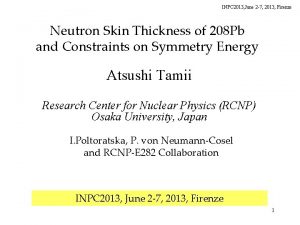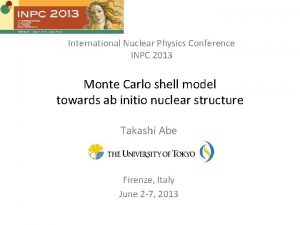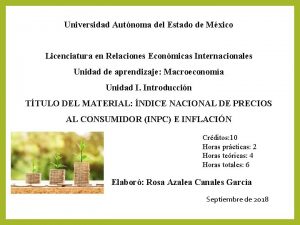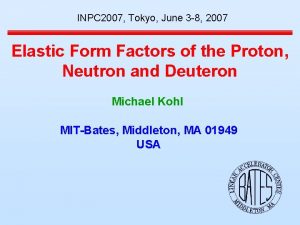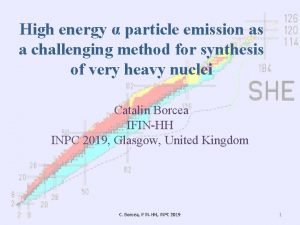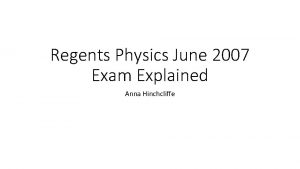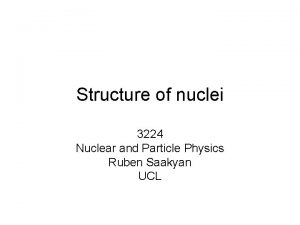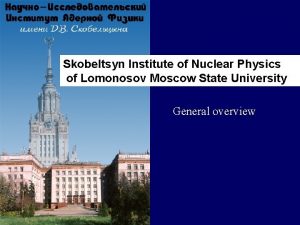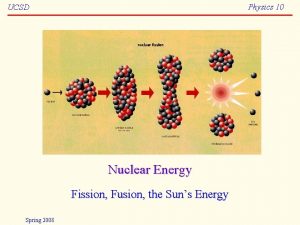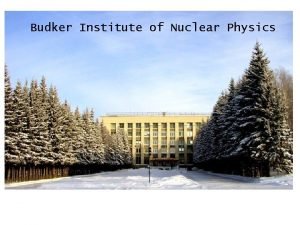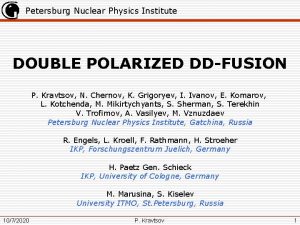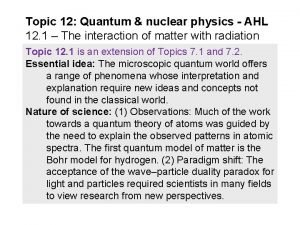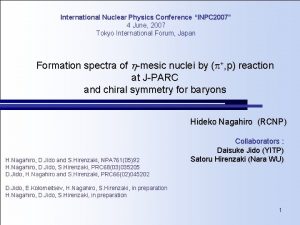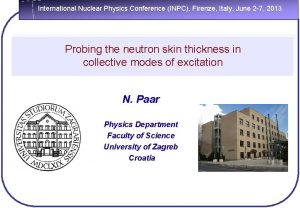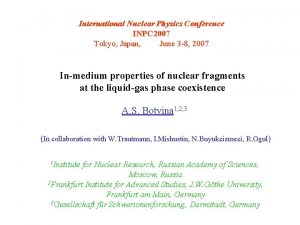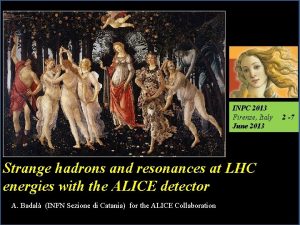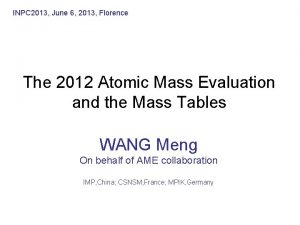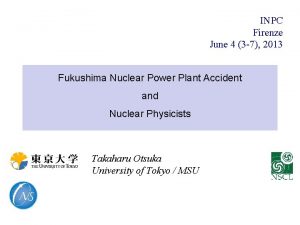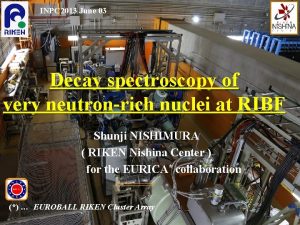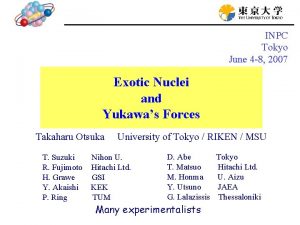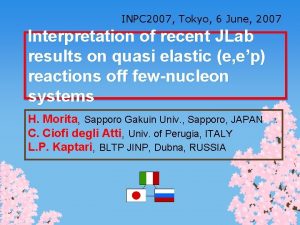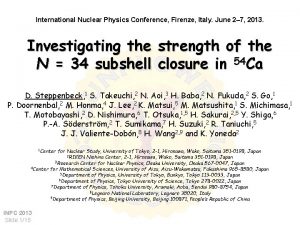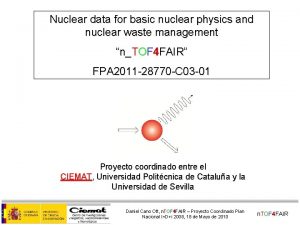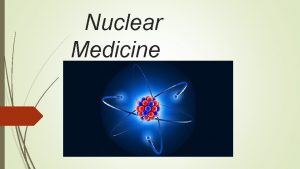International Nuclear Physics Conference INPC 2013 June 2


















- Slides: 18

International Nuclear Physics Conference (INPC 2013) June 2 -7, 2013, Firenze, Italy Magnetic and Antimagnetic Rotation in Covariant Density Functional Theory Pengwei Zhao School of Physics, Peking University Collaborators: H. Z. Liang, Jie Meng, J. Peng, P. Ring, and S. Q. Zhang

Magnetic Rotation (MR) ü near spherical or weakly deformed nuclei ü strong M 1 and very weak E 2 transitions ü rotational bands with I = 1 ü shears mechanism Frauendorf NPA 1993 Hübel PPNP 2005 2021/3/8 CDFT - P W Zhao 2

Antimagnetic Rotation (AMR) Magnetic rotation Ferromagnet ü rotational bands with ΔI = 1 ü near spherical nuclei; weak E 2 transitions ü strong M 1 transitions ü B(M 1) decrease with spin ü shears mechanism Antimagnetic rotation Antiferromagnet ü rotational bands with ΔI = 2 ü near spherical nuclei; weak E 2 transitions ü no M 1 transitions ü B(E 2) decrease with spin ü two “shears-like” mechanism Frauendorf 1995

Experiment: MR Magnetic rotation: 85 nuclei Meng, Peng, Zhang, PWZ, Front. Phys. 8, 55 (2013)

Experiment: AMR A~100 Small B(E 2) Decrease tendency Large J(2)/B(E 2) Increase tendency Simons PRL 2003; Simons PRC 2005

Theory ü Semiclassical particle plus rotor model Clark ARNPS 2000 simple geometry for the energies and transition probabilities ü Pairing-plus-quadrupole tilted axis cranking (TAC) model Frauendorf NPA 1993; Frauendorf NPA 2000 schematic Hamiltonian A fully self-consistent microscopic model? Density functional theory

DFT: Cranking version • TAC based on Covariant Density Functional Theory Meson exchange version: 3 -D Cranking: Madokoro, Meng, Matsuzaki, Yamaji, PRC 62, 061301 (2000) 2 -D Cranking: Peng, Meng, Ring, Zhang, PRC 78, 024313 (2008) Point-coupling version: Simple and more suitable for systematic investigations 2 -D Cranking: PWZ, Zhang, Peng, Liang, Ring, Meng, PLB 699, 181 (2011) • TAC based on Skyrme Density Functional Theory 3 -D Cranking: Olbratowski, Dobaczewski, Dudek, Płóciennik, PRL 93, 052501(2004) 2 -D Cranking: Olbratowski, Dobaczewski, Dudek, Rzaca-Urban, Marcinkowska, Lieder, APPB 33, 389(2002) Fully self-consistent microscopic investigations Ø fully taken into account polarization effects Ø self-consistently treated the nuclear currents Ø without any adjustable parameters for rotational excitations In this presentation The self-consistent TAC model based on CDFT with PC interaction Investigation of MR and AMR bands in a fully self-consistent and microscopic way.

Tilted axis cranking CDFT General Lagrangian density Transformed to the frame rotating with the uniform velocity x z Koepf NPA 1989; Kaneko PLB 1993; Madokoro PRC 1997

Equations of motion Dirac Equation Potential Spatial components of vector field are involved due to the time-reversal invariance broken

Observables Binding energy Angular momentum Quadrupole moments and magnetic moments B(M 1) and B(E 2) transition probabilites Where

MR: 60 Ni ü Harmonic oscillator shells: Nf = 10 ü Effective interaction: PC-PK 1 PWZ, Li, Yao, Meng, PRC 82, 054317 (2010) ü Configurations: Torres et al, PRC 78, 054318 (2008) PWZ, Zhang, Peng, Liang, Ring, Meng, PLB 699, 181 (2011)

MR: 60 Ni PWZ, Zhang, Peng, Liang, Ring, Meng, PLB 699, 181 (2011) ü The experimental energies are reproduced quite well (except the larger spin part) ü For high-spin states in band M-1 and M-3, Config 1* and Config 3* are switched in.

MR: 60 Ni Magnetic Rotation Electric Rotation PWZ, Zhang, Peng, Liang, Ring, Meng, PLB 699, 181 (2011)

AMR: 105 Cd u Harmonic oscillator shells: Nf = 10 u Effective interaction: PC-PK 1 PWZ, Li, Yao, Meng, PRC 82, 054317 (2010) u Configurations: u Polarizations: 107 Sn Choudhury et al, PRC 82 , 061308 (2010) 107 Sn + [(g 9/2)-2] 105 Cd PWZ, Peng, Liang, Ring, Meng PRL 107, 122501(2011)

AMR: 105 Cd PWZ, Peng, Liang, Ring, Meng PRL 107, 122501(2011) ü The calculated B(E 2) values are in excellent agreement with the data. ü The B(E 2) values decrease with the increasing spin ü Without polarization, the B(E 2) values drop to zero when the spin large than 17ħ. ü Without polarization, the nucleus changes to be a oblate shape when the spin large than 17ħ. ü It is of importance to emphasize that polarization effects play a very important role in the self-consistent microscopic description of AMR bands, especially for the E 2 transitions.

AMR: two “shears-like” mechanism PWZ, Peng, Liang, Ring, Meng PRL 107, 122501(2011) ü The angular momentum is increased due to the alignment of two proton holes ü The two “shears-like” mechanism is excellently presented.

AMR: single particle angular momentum PWZ, Peng, Liang, Ring, Meng PRC 85, 054310 (2012) ü For the protons, only the two holes in the g 9/2 shell contribute. ü For the neutrons, the particles above the N= 50 shell contribute. ü Angular momentum increases due to the alignment of proton holes and the mixing within the neutron orbitals. ü Due to the strong mixing between neutrons, a core in the phenomenological model cannot be well defined.

Summary Ø Covariant density functional theory has been extended to describe rotational excitations including MR and AMR. Ø MR: 60 Ni 58 Fe 198 Pb, 199 Pb Ø AMR: 105 Cd PWZ, Zhang, Peng, Liang, Ring, Meng, PLB 699, 181 (2011) Steppenbeck et al. , PRC 85, 044316 (2012) Yu, PWZ, Zhang, Ring, Meng, PRC 85, 024318 (2012) PWZ, Peng, Liang, Ring, Meng PRL 107, 122501(2011) PWZ, Peng, Liang, Ring, Meng PRC 85, 054310 (2012) 112 In Li et al. , PRC 86, 057305 (2012). Thank you very much for your attention!
 Inpc 2013
Inpc 2013 Inpc 2013
Inpc 2013 Inpc 2013
Inpc 2013 Inpc 2013
Inpc 2013 Caleidoscopio inpc
Caleidoscopio inpc Inpc 2007
Inpc 2007 Inpc
Inpc Lesson 15 nuclear quest nuclear reactions
Lesson 15 nuclear quest nuclear reactions Fisión nuclear vs fision nuclear
Fisión nuclear vs fision nuclear June 2007 physics regents
June 2007 physics regents Agile 2013 conference
Agile 2013 conference Physics topic 12
Physics topic 12 Magic nuclei
Magic nuclei Skobeltsyn institute of nuclear physics
Skobeltsyn institute of nuclear physics Nuclear fission
Nuclear fission Scattering cross section in nuclear physics
Scattering cross section in nuclear physics Budker institute of nuclear physics
Budker institute of nuclear physics Petersburg nuclear physics institute
Petersburg nuclear physics institute Quantum nuclear physics
Quantum nuclear physics

